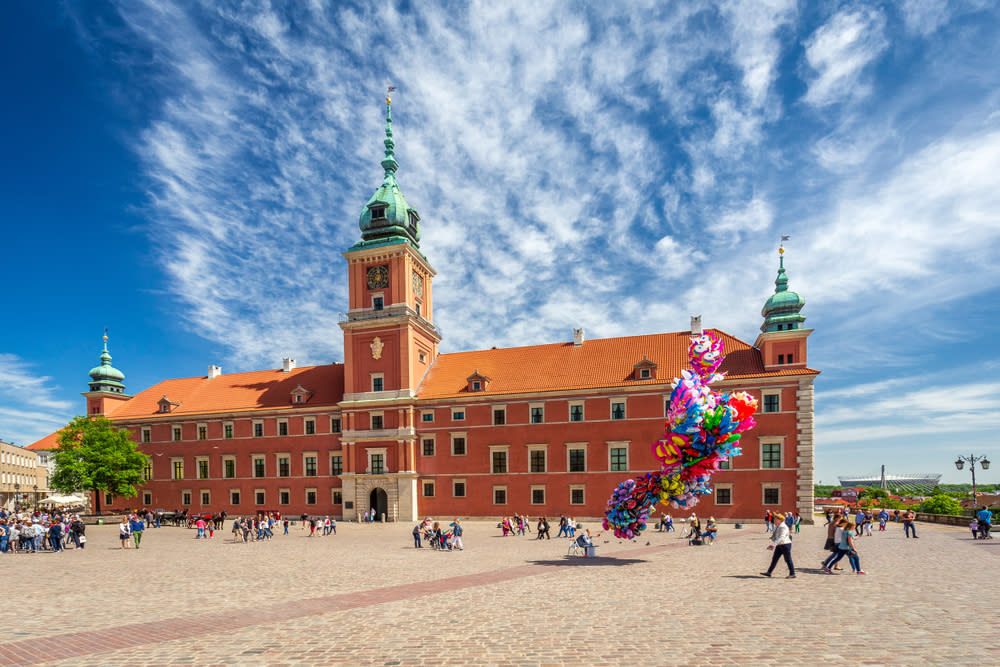More from Warsaw
Main Menu
- 00:00
- 06:00
- 12:00
- 18:00
- 23:00
Warsaw : Next 24-Hour Weather
Today - 12th April 2025
Sunrise 05:46
Sunset 19:30
Tomorrow - 13th April 2025
Sunrise 05:46
Sunset 19:30
Holiday Weather Now
Sorted by popularity:
Updated at 16:01 GMT
-
Temp feels like16°C62°F
-
Length of day13h 44m
-
Pressure29" (1015 hpa)
-
Visibility10 km (6miles)
-
Wind speed7 km/h
Sunrise 05:46
Sunset 19:30
-
Temp feels like:
16ºC (62 ºF)
-
Length of day:
13h 44m
-
Pressure:
29" (1015 hpa)
-
Visibility:
6 miles (10 km)
-
Wind speed:
7 km/h
Warsaw, the capital of Poland, sits on the Vistula River in east-central Poland. The city receives a humid continental climate with all four seasons and moderate rainfall with pronounced wet and dry periods. Warsaw sees its wettest weather in the summer. Summers are mild and winters are cold and snowy. The weather in Warsaw is characteristically unpredictable so no matter the trend of the season, visitors to the city should come prepared for colder weather.<?xml:namespace prefix = o ns = "urn:schemas-microsoft-com:office:office" />
Summer in Warsaw, from June till September, is usually warm and humid. The average daytime high is around the low 20s, with the peak months of July and August seeing an average high of 23°C. At night it usually cools down considerably, approaching 10°C. Nights definitely require some extra layers, and air-conditioning is probably unnecessary. However, day time highs are quite erratic and often reach up to 30°C. The high temperatures are said to be exacerbated by heavy urbanisation; an abundance of concrete keeps temperatures artificially high. September is much cooler than the early summer months as autumn weather approaches, with an average high of 18°C. Summer is not as humid as winter but it can still become uncomfortable. This is the rainiest time of year with June seeing the heaviest rain and July coming an incredibly close second. On average, rain falls on just under half of the days in each month, but showers donât tend to last for too long. Sunshine levels are highest in June with an average of eight hours of sunshine per day, July and August see seven hours per day, and September sees five.
While you will have to cope with a few wet days if visiting at this time, this is still the warmest, sunniest and generally most pleasant time to experience Warsaw. Trips to the city usually focus around its cultural and historical attractions so sunbathing weather is not exactly a necessity, but of course warm, sunny days make all the difference and you will get your fair share of these.
Autumn, in October and November, sees temperatures drop from a mild 18°C in September to a cool 13°C in October and a cold 6°C in November. Night time temperatures drop accordingly and by November they near freezing. Precipitation levels drop but rain is still quite frequent. Snow often starts to fall in November and frosts are common from early in the month. Sunshine levels reduce quite dramatically to three hours per day in October and one hour per day in Novemeber, so be prepared for some grey. Warsaw is beautiful in autumn as its many parks turn red and gold, so perhaps itâs worth braving a bit of dodgy grey weather.
Winter is cold and lasts from December till February. The average high temperature fluctuates between 1°C and -1°C. At night temperatures drop below freezing, usually getting down to around -5°C. Again, speaking of average conditions wonât really prepare tourists for Warsaw as the weather is unreliable to the point of dishonesty. While the average coldest temperature may be -5°C, Warsaw has been known to see periods of extreme cold around -20°C. In this season precipitation drops; January and February are the driest months; about half of precipitation that does fall falls in the form of snow in lower areas, and exclusively as snow in the mountains. December sees the beginning of the ski season which lasts into March. However, the nearest ski resorts are around 200 miles from the city so youâll have to get up pretty early in the morning if you intend to base yourself in the city. Sunshine levels remain pretty dire with only one hour per day on average in December and January rising to two in February.
Spring, from March till May, is mild and unpredictable. The average high temperature rises from 6°C in March to a pleasant 19°C in May, though night times remain cold, not getting above ten degrees even in May. Rainfall begins to increase as the snow thaws and the effect is a wet city. By May rainfall is almost at its highest levels. Unfortunately this means that Warsaw is at risk of flooding as the melted snow and heavy rain test the banks of the Vistula.
Polandâs changeable weather is due to many contrasting weather systems converging from different directions. The multitude of variables makes predictions difficult to make and surprises a regular occurrence. Warsawâs lower areas and the rest of the land around the Vistula actually receive low levels of precipitation in comparison to the rest of the country.

















